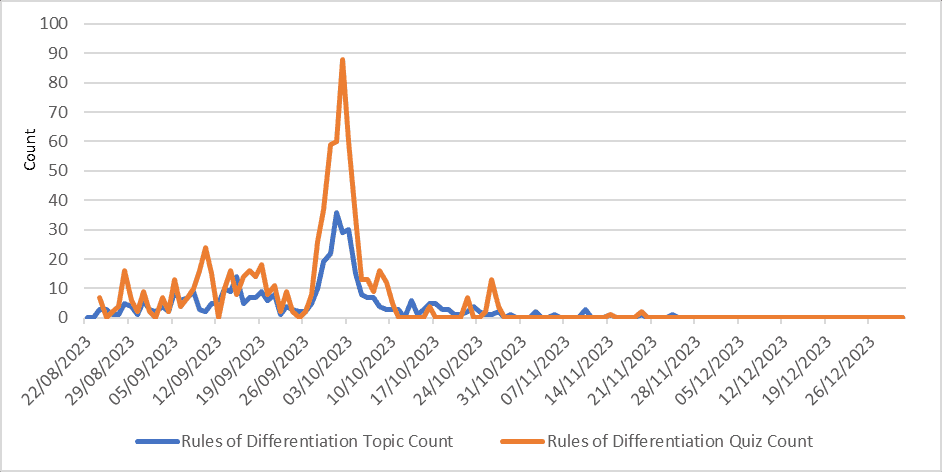Supporting Economics Students’ Transition to University with Mathematics Revision Resources
Caroline Elliott, Andrew Brendon-Penn, Emil Kostadinov & Jeremy Smith
University of Warwick
Published April 2024
Introduction
Undergraduate economics students are likely to begin their university studies with very different levels of mathematics knowledge. Not only do universities have different mathematics entry criteria for new undergraduate economics students, but mathematics entry criteria may differ according to students’ degree choice, for example the mathematics entry criteria may differ according to whether students choose to study for a single honours or joint honours degree. In addition, students may previously have studied mathematics in different countries, may have taken different pre-university mathematics examinations, with different syllabi depending on the examinations body. Some students may have studied mathematics until just a couple of months before they begin their university studies, while others may not have studied mathematics for some years.
Hence, the provision of mathematics refresher resources to economics undergraduate (and possibly postgraduate) students may be very valuable. Further, there is evidence that mathematics ability may be associated with student success in university economics courses, see for example Denny (2014); McAlinden and Noyes (2019).
Each topic also includes a video discussion of how the mathematics concepts covered may be used in an economics context.
Refresher Mathematics Resources
The University of Warwick Economics Department has been providing new undergraduate (and MSc) students with online refresher mathematics resources each year since 2021. There are now six broad topics covered, namely precalculus; univariate calculus; multivariate calculus; sequences and series; matrices; probability and statistics. New BSc Economics students have taken A-level Mathematics or equivalent and so are expected to work through each of the topics listed above. Joint degree students are not required expected to have A-level Mathematics (or equivalent) and may have stopped their mathematics training around the age of 16. As such, they are only expected to work through the precalculus section of the resources.
Each topic begins with a diagnostic test. Students are advised to take these tests so that they can decide where they have any gaps in their knowledge. Then, they can navigate through short explanatory films and text, with multiple further opportunities to test their knowledge by answering more short questions. Questions were co-created with students using NUMBAS. This software allows questions to be set with randomisation of parameters such that if students want multiple questions to practice on a particular topic, then each question will be different. It is intended that repetition and reinforcement of the use of mathematical techniques will ensure longer term recall. Each topic also includes a video discussion of how the mathematics concepts covered may be used in an economics context.
Demand for the resources
The resources are made available approximately one month before students arrive on campus to start their studies, and are accessed via the Virtual Learning Environment (VLE), namely Moodle. Chart 1 below summarises student demand in the autumn term of the 23/24 academic year for the arithmetic diagnostic quiz and arithmetic materials that all students are expected to work through at the start of the precalculus topic.
Chart 2 similarly summarises student demand, but for the material on rules of differentiation that forms part of the univariate calculus section of the resources. This topic was chosen as knowledge of the rules of differentiation will be essential for all BSc Economics students. Nevertheless, only single honours students were expected to look at this topic in advance of starting their studies. Hence, the number of ‘hits’ on the resources was expected to be lower than the ‘hits’ on the precalculus arithmetic resources.
Chart 1: Demand for Arithmetic Refresher Resources

Chart 2: Demand for Rules of Differentiation Refresher Resources

The charts above highlight the level of student demand for the VLE refresher mathematics resources. While students are recommended to work through the resources, their engagement with the resources is not actively monitored. As such, this use of the resources can be considered to reflect students’ revealed preference for the resources.
Royal Economic Society funding was obtained when the resources were first created (the online resources continue to be updated annually). Once the refresher mathematics resources were created and confirmed to be working without problems, it was agreed the resources would be made available more widely. Hence, since March 2022 a basic version of the resources has also been made available via The Economics Network,
https://www.economicsnetwork.ac.uk/maths_refresher/
Again, usage suggests students’ revealed preference for these resources. The data below relate to the most recent full UK academic year for which data are available.
Table 1: Examples of Demand via The Economics Network

Source: Google Analytics, October 2022 to October 2023 usage
Future research
The discussion above highlights student demand for refresher mathematics resources, both at the University of Warwick and more widely. Further research now needs to be undertaken on the optimal design of any future resources created, as well as on the impact of student engagement with refresher mathematics resources on student performance.
References
E. Denny (2014) Factors influencing the performance of non-economics majors in an introductory economics course, International Review of Economics Education, 17, 1-16. https://doi.org/10.1016/j.iree.2014.04.003
M. McAlinden and A. Noyes (2019) Mathematics in the disciplines at the transition to university, Teaching Mathematics and its Applications: An International Journal of the IMA, 38(2), 61-73. https://doi.org/10.1093/teamat/hry004

